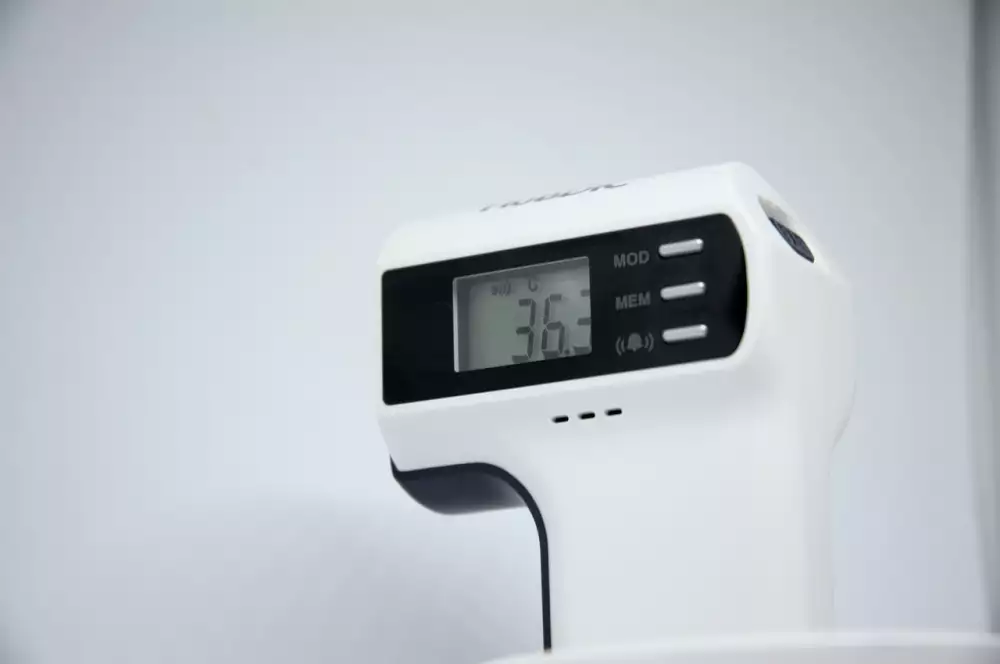Non-contact thermometer: a modern medical device for safe temperature measurement

- What is a proximity thermometer and how does it work?
- Benefits of using a non-contact thermometer in medicine.
- Safety and hygiene when using a non-contact thermometer.
- Different types of non-contact thermometers and their characteristics.
- How to use a proximity thermometer correctly to get accurate results
- Comparison of a non-contact thermometer with traditional thermometers.
- Recommendations for selecting and purchasing a non-contact thermometer.
- Frequently asked questions and answers about non-contact thermometers in medicine.
- Non-contact thermometers and their use in today's healthcare industry.
- The future of non-contact thermometers in medicine
What is a proximity thermometer and how does it work?
A non-contact thermometer is a modern medical device that allows you to measure temperature without physical contact with the body. The principle of operation is that the thermometer emits infrared rays onto the surface of the skin and then picks up the reflected rays. Based on this information, the body temperature is then calculated. This type of thermometer is fast, accurate and comfortable for patients and staff.
Benefits of using a non-contact thermometer in medicine.
The non-contact thermometer brings many advantages for use in medicine. One of the main advantages is the ability to measure temperature without physical contact with the patient, which minimizes the risk of transmitting infections. This type of thermometer is also very fast and easy to use, saving time for medical personnel. Its non-contact principle makes it suitable for measuring temperature in children, who are often uncomfortable or fearful when using traditional thermometers. Another advantage is the ability to measure temperature on different parts of the body such as the forehead, ear or even by non-contact scanning of the face. This allows medical personnel to choose the most appropriate place to take the temperature depending on the needs of the patient. Overall, the non-contact thermometer is a modern and effective tool for safe and convenient temperature measurement in medicine.
Safety and hygiene when using a non-contact thermometer.
The non-contact thermometer is a modern medical device that allows you to measure temperature without physical contact with the body. This minimises the risk of infection transmission and ensures a higher level of hygiene. When using a non-contact thermometer, it is important to observe several precautions. It is necessary to regularly clean the surface of the thermometer with disinfectants and keep it in a sterile condition. It is also important to ensure that the thermometer is stored correctly to avoid damage or contamination. It is also important to maintain the correct distance from the patient's body when taking the temperature and to aim the thermometer at the correct part of the body for the most accurate results. Following these principles can ensure the safe and hygienic use of non-contact thermometers in medicine.
Different types of non-contact thermometers and their characteristics.
There are several different types of non-contact thermometers that differ in their features and functions. The most common type is the infrared non-contact thermometer, which measures temperature using infrared radiation emitted by the body. This type of thermometer is fast, accurate and easy to use. Another type is the thermal camera, which allows visualization of temperature differences on the surface of the body. This type of thermometer is suitable for scanning larger areas and detecting hot or cold areas. Some non-contact thermometers also have the option of remembering the last reading or an automatic shut-off function to save energy. Each type has its own features and uses, so it is important to choose the right one for the user's needs and requirements.
How to use a proximity thermometer correctly to get accurate results
To use a non-contact thermometer correctly and get accurate results, it is important to follow a few guidelines. Firstly, you need to place the thermometer at the correct distance from the object to be measured, it is usually recommended to hold it at a distance of 3-5 cm from the forehead. It is also important to aim the thermometer directly at the centre of the forehead to ensure the most accurate measurement. It is advisable to keep still and not touch the thermometer during the measurement to avoid affecting the result. After taking the measurement, it is a good idea to write down the reading and, if necessary, compare it with reference values for the person or situation.
Comparison of a non-contact thermometer with traditional thermometers.
Comparing a non-contact thermometer with traditional thermometers is important to understand the benefits of a modern device. A non-contact thermometer allows you to measure temperature without physical contact with your body, which means there is no need to use a traditional mercury or digital thermometer in your mouth, under your arm or in your ear. This minimises the risk of infection transmission and increases hygiene. Non-contact thermometers also make it quick and convenient to take temperatures without waiting for a result. This is particularly useful when taking temperatures in young children or sick patients who are prone to the discomfort associated with traditional measurements. Overall, non-contact thermometers offer a higher level of comfort, safety and hygiene compared to traditional thermometers.
Recommendations for selecting and purchasing a non-contact thermometer.
When choosing a non-contact thermometer, it is important to consider several factors. First, choose a thermometer from a reputable manufacturer with a good reputation. Next, focus on the accuracy of the measurement and the speed of the temperature reading. It is also advisable to choose a thermometer with sufficient memory to store the readings. Other factors to consider are ease of use, readability of the display and the ability to set different measurement modes. Before buying, read reviews and compare prices of different models.
Frequently asked questions and answers about non-contact thermometers in medicine.
Here are some common questions and answers about non-contact thermometers in medicine:
1. How does a non-contact thermometer work?
A non-contact thermometer measures temperature using infrared radiation that is captured by a sensor. This sensor converts the radiation into a temperature value.
2. Is the non-contact thermometer hygienic?
Yes, a non-contact thermometer is very hygienic because it does not need physical contact with the body surface. Just point it at the patient's forehead or ear and take the temperature.
3. Are non-contact thermometers accurate?
Yes, modern non-contact thermometers are very accurate and provide reliable temperature results.
4. Can an infection be transmitted by a non-contact thermometer?
No, it is not possible to transmit infection with a non-contact thermometer because there is no physical contact with the patient's body.
5. Can a non-contact thermometer be used on young children?
Yes, non-contact thermometers are suitable for use in young children because they are quick, convenient and non-invasive.
6. How often do you need to calibrate a non-contact thermometer?
Contactless thermometers usually do not need calibration, but it is a good idea to check their accuracy periodically.
7. How long does it take to take a temperature reading with a non-contact thermometer?
Measuring temperature with a non-contact thermometer takes only a few seconds, which is very fast and efficient.
8. Can the non-contact thermometer be used on multiple patients?
Yes, the non-contact thermometer can be used on multiple patients as long as the sensor is disinfected in between.
9. What is the difference between a non-contact and an ear thermometer?
A non-contact thermometer can measure temperature from both the forehead and the ear, while an ear thermometer can only measure from the ear.
10. Are non-contact thermometers suitable for home use?
Yes, non-contact thermometers are suitable for home use due to their simplicity, speed and accuracy in measuring temperature.
Non-contact thermometers and their use in today's healthcare industry.
Touchless thermometers have become an integral part of modern healthcare. Their use is wide and varied. They are used in measuring the temperature of patients in hospitals, clinics and home environments. Their speed and accuracy make them an ideal tool for temperature monitoring in children, the elderly or patients with limited mobility. Thus, non-contact thermometers contribute to improved diagnosis and patient care, which has a positive impact on the overall course of treatment.
The future of non-contact thermometers in medicine
The future of non-contact thermometers in medicine is very promising. With technological advances, these thermometers are expected to become increasingly accurate and easier to use. Research and development is focusing on improving sensors to measure temperature without body contact, allowing for even faster and more reliable diagnosis. In addition, non-contact thermometers are expected to be able to measure other parameters such as heart rate or blood pressure. These innovations will bring new possibilities for patient monitoring and improved diagnosis to medicine. Overall, non-contact thermometers have the prospect of becoming an integral part of modern healthcare.
Published: 20. 01. 2024
Category: medicine




